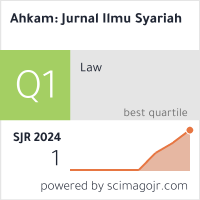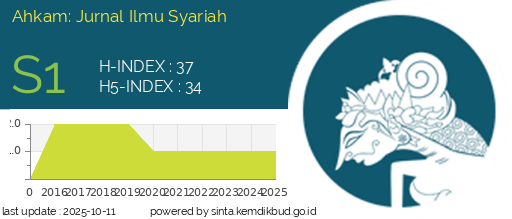Interreligious Marriages: Can Couples in Interfaith Marriages Live a Happy Life?
DOI:
https://doi.org/10.15408/ajis.v25i1.37317Keywords:
Happy, Interreligious Marriage, Love, Family, SakinahAbstract
This article posits that families of interfaith couples (Muslims and Christianity/Catholicism) can achieve a state of happiness. Research data were obtained through in-depth interviews with married couples comprising one Indonesian and a British partner, aged between 25 and 40 years, residing in Indonesia and the United Kingdom, and representing diverse religious and cultural backgrounds The study revealed that the Islamic concept of sakīnah family embodies a totality of mercy (raḥmah) and love (mawaddah) inherently present in each couple's heart. The findings suggest that happiness in interreligious or interfaith marriages can be attributed to the profound love shared by the spouses. Love can develop and grow in a romantic, intimate, passionate, and committed relationship, provided there is a willingness to accept responsibility for maintaining it. Accordingly, these research findings may have implications for a new understanding of the sakīnah family, which, thus far, has been based upon the standard of couples having a common faith in a same-religion marriage. Nonetheless, further studies are needed to investigate whether couples in interfaith and interreligious marriages continue to lead happy lives in their old age.
Abstrak
Artikel ini menjelaskan bahwa keluarga pasangan beda agama (Muslim dan Kristen/Katolik) bisa mencapai kehidupan yang bahagia. Data penelitian diperoleh dari wawancara mendalam dengan pasangan dari latar belakang agama dan budaya yang berbeda berusia 25-40 tahun yang berasal dari Indonesia dan Inggris. Penelitian menemukan bahwa konsep keluarga sakinah dalam ajaran Islam adalah totalitas rahmat (raḥmah) atau cinta (mawaddah) yang ada dan melekat dalam hati setiap pasangan. Temuan penelitian menunjukkan bahwa kebahagiaan dalam hubungan suami istri dalam perkawinan beda agama dapat ditemukan karena besarnya rasa cinta yang dimiliki oleh pasangan tersebut. Cinta dapat tumbuh dan berkembang dalam suatu hubungan yang bersifat romantis, intim, penuh gairah dan komitmen serta kesediaan menerima tanggung jawab untuk menjaga hubungan. Dengan demikian, temuan penelitian ini memiliki implikasi pada pemahaman baru tentang keluarga sakinah, yang, sejauh ini, telah didasarkan pada standar pasangan yang memiliki keyakinan yang sama dalam pernikahan sesama agama. Meskipun demikian, studi lebih lanjut di masa depan diperlukan untuk mengamati apakah pasangan pernikahan beda agama dan antaragama masih menjalani kehidupan yang bahagia di usia tua mereka?
References
Adriani, Y. (2020). Happiness and religiosity in young Indonesian Muslims. Jakarta: Horizon Books.
Aini, N., et.al. (2017). “Mata rantai Transmisi dan Transformasi ideologi kekerasan agama [The chain of the transmission and transformation of religious radical ideology].” Research Report. Jakarta: Lembaga Penelitian dan Pengabdian pada Masyarakat, Universitas Islam Negeri Syarif Hidayatullah Jakarta.
Al-Jauziyyah, I.Q. (2005). At-tafsir al-qayyim. Bairut: Dar al-Kutub al- Ilmiyah.
Al-Kandari, Y.Y. (2011). Religiosity, social support, and health among the elderly in Kuwait. Journal of Muslim Mental Health, 6(1), 81-98.http://hdl.handle.net/2027/spo.10381607.0006.106
Al-Zuhaili, Wahbah. (2009). Al-tafsir al munir fi al-‘aqidah wa al-syari’ah wa manhaj. Damaskus: Dar al-Fikr.
Andayani, B., Ancok, D and Wulan, R. (2018). From love to family happiness: a theoretical model for Javanese family. European Journal of Social Science April 2018 Education and Research, 5(1), 24-35. DOI: 10.2478/ejser-2018-0003
Antonsen, J. L. (2003). God in the marital triangle: a phenomenological study of the influence of Christian faith in the marriage relationship. Master’s thesis, Trinity Western University. https://www.twu. ca/sites/default/files/antonsenjennifer.pdf. Accessed 13 Aug 2023.
B.T., Akhmedov. (2021). The family as the basic unit of society. International Journal of Multicultural and Multireligious Understanding, 8(12), 201-204.
Ball, R., & Chernova, K. (2008). Absolute income, relative income, and happiness. Social Indicators Research, 88, 497–529.
Baso, A. and Nurcholish, A. (2010). Pernikahan beda agama: kesaksian, argumen keagamaan, dan analisis kebijakan [Interreligious marriage: testimonies, religious arguments and policy analysis]. Jakarta: Komnas HAM and ICRP.
Boniwell, I., David, S.A. and Ayers, A.A. (2013). Oxford Handbook of Happiness. Oxford: Oxford University Press.
Botha, F. (2014). Life satisfaction and education in South Africa: investigating the role of attainment and the likelihood of education as a positional good. Social Indicators Research, 118, 555–578.
Botha, F. (2014). Life satisfaction and education in South Africa: investigating the role of attainment and the likelihood of education as a positional good. Social Indicators Research, 118, 555–578.
Carr, D., and Springer, K. W. (2010). Advances in families and health research in the 21st century. Journal of Marriage and Family, 72, 743–761.
Chen, W.c. (2012). How education enhances happiness: comparison of mediating factors in four east Asian countries. Social Indicators Research, 106, 117–131.
Chen., N. and Chen, H.C. (2021). Religion, marriage and happiness – evidence from Taiwan. Applied Research in Quality of Life. 16, 259–299.https://doi.org/10.1007/s11482-019-09765-6
Clavería, A.V. (2019). Romantic relationships in chilean adolescents a necessary emotional dimension in human development. Orientación y Sociedad. 19 (1), 1-16.
Clingan, P.D. (2021).Types of love between people: a modern perspective using a descriptive assessment of survey research. International Journal of Scientific Advances, 2(3), 331-338.DOI: 10.51542/ijscia.v2i3.17
Connolly, J. A., Craig, W., Goldberg, A.., & Pepler, D. (2004). Mixed-gender groups, dating, and romantic relationships in early adolescence. Journal of Research on Adolescence, 14, 185-207.
Cuñado, J., & de Gracia, F. P. (2012). Does education affect happiness? Evidence for Spain. Social Indicators Research, 108(1), 185–196.
Davis, W. (1980). A theory of happiness. American Philosophical Quarterly, 18(2), 111-120.
Ede, S.S. et al. (2023). Impact of religious participation and spirituality on the health of Nigerian older people: an online survey. Journal of Religion, Spirituality & Aging, 35(1), 56-70, DOI: 10.1080/15528030.2021.2001407
Elmslie, B.T. and Tebaldi, E. The determinants of marital happiness. Applied Economics, 46(28-30), 3452-3462.
Fauzan., A and Amroni., H. (2020). The concept of sakīnah family in the contemporary muslim generation. Al-‘adalah, 17(1), 51-70. DOI: https://doi.org/10.24042/adalah.v17i1.6458
Frankl, V.E. (2012). Der Wille zum Sinn. München: Huber.
-------, (2011). The Unheard Cry for Meaning. New York: Touchstone.
-------, (2018). Der leidende Mensch: Anthropologische Grundlagen der Psychotherapie. Bern: Hogrefe.
Geiger, BB. and MacKerron, G. (2016). Can alcohol make you happy? A subjective wellbeing approach. Social Science & Medicine, 156, 184-191.
Gordon, A. (2018). Marriage, religion, and women's happiness. Honors Theses, 1701. Available from https://digitalworks.union.edu/theses/1701.
Hou, B., Wu, Y and Huang, Y. (2023). How does religious belief affect happiness of older adults: the participation effect and support effect. Religions 14: 243. https://doi.org/ 10.3390/rel14020243
Hughes, P. C., & Dickson, F. C. (2005). Communication, marital satisfaction, and religious orientation in interfaith marriages. The Journal of Family Communication, 5, 25–41.
Johnson, J. K. M., Pitt-Catsouphes, M., Besen, E., Smyer, M., and Matz-Costa, C. (2008). Quality of employment and life-satisfaction: A relationship that matters for older workers (Issue Brief No. 13). Chestnut Hill, MA: Sloan Center on Aging & Work at Boston College. Tersedia di: https://dlib.bc.edu/islandora/object/bc-ir:100070/datastream/PDF/view
Latifa, R., Hidayat, K., and Sodiq, A. (2019). Commentary on place spirituality: an Islamic perspective. Archive for the Psychology of Religion , 41(1) 38–42. https://doi.org/10.1177/0084672418825314
Layard, R. (2011) Happiness: lessons from a new science. London: Penguin.
Lee, K. S. and Ono, H. (2012). Marriage, cohabitation, and happiness: a cross national analysis of 27 countries. Journal of Marriage and Family, 74: 953–972.
Lehrer, E. L., & Chiswick, C. U. (1993). Religion as a determinant of marital stability. Demography, 30, 385– 404.
Leontiev, D. (2012). Anthropology of happiness: the state of well-being and the way of joy. Social Sciences, 2, 93-104.
Levenson, R. W., Carstensen, L. L., and Gottman, J. M. (1993). Long-term marriage: Age, gender, and satisfaction. Psychology and Aging, 8, 301–313.
Lewis, C. A., Maltby, J., and Burkinshaw, S. (2000). Religion and happiness: still no association. Journal of Beliefs & Values, 21, 233–236.
Locke, J. (2019). An essay concerning human understanding. Neeland Media LLC: La Vergne.
Margelisch, K., Schneewind, K. A., Violette, J., and Perrig-Chiello, P. (2017). Marital stability, satisfaction and well-being in old age: variability and continuity in long-term continuously married older persons. Aging & Mental Health, 21, 389–398.
Marks, L. (2003). The effects of religious beliefs in marriage and family. Marriage and Families, 11, 2–10.
Marks, L. (2005). How does religion influence marriage? Christian, Jewish, Mormon, and Muslim perspectives. Marriage & Family Review, 38, 85–111.
Martin, M. (2012). Happiness and the good life. Oxford: Oxford UP.
Mayowa, I.O. (2019). Family institution and modernization: a sociological perspective. Research on Humanities and Social Sciences, 9(8), 99-105.
Moghaddam, M. (2008). Happiness, faith, friends, and fortune – empirical evidence from the 1998 US survey data. Journal of Happiness Studies, 9, 577–587.
Moordiningsih. (2011). Family as a source of happiness and achievement: indigenous psychology. In 2nd International Conference of Indigenous and Cultural Psychology, 21-23 Desember 2011.
Munawwir, A.W. (1997). Kamus Al-Munawwir Arab-Indonesia. Surabaya: Pustaka Progresif.
Napa, Wilai, et.al. (2020). Family happiness among people in a Southeast Asian city: grounded theory study. Nursing and Healt Science, 22, 292-299.
Peraturan Pemerintah Nomor 9 Tahun 1975 tentang Perkawinan
Perry, S. L. (2016). Spouse's religious commitment and marital quality: clarifying the role of gender. Social Science Quarterly, 97: 476–490.
Pongoliu, H. (2017). Family of Sakinah, Mawaddah, Warahmah in the concept of Islamic marriage. Al Mizan, 13(1), 1-16.
Proulx, C. M., Helms, H. M., and Buehler, C. (2007). Marital quality and personal well-being: a meta-analysis. Journal of Marriage and Family, 69, 576–593.
Rahman, M.M (2015). Mental health: Islamic perspective. Qudus International Journal of Islamic Studies, 5(1), 54-71.
Riese, J. (2018). What is ‘access’ in the context of qualitative research? Qualitative Research, 19(6), 669–684. https://doi.org/https://doi.org/10.1177/1468794118787713
Rizvi, M.A.K. and Hossain, M.Z. (2017). Relationship Between Religious Belief and Happiness: A Systematic Literature Review. Journal of Religion and Health, 56(5), 1-22, 10.1007/s10943-016-0332-6
Sander, William. (2017). Religion, religiosity, and happiness. Review of Religious Research : The Official Journal of the Religious Research Association, 59, 251.
Santos, A.L., Natividade, J.C. and Carneiro, T.F. (2021). Do romantic relationships promote happiness? relationships’ characteristics as predictors of subjective well-being. Interpesona,15(1),3-19. https://doi.org/10.5964/ijpr.4195
Sapiro, P. (2020). Religious intermarriage in England and Wales: differences in individual and area characteristics of endogamous and exogamous couples. Eur J Population, 36, 415. https://doi.org/10.1007/s10680-019-09534-z
Sari, M. (2017). The impacts of the age factor on religiosity. The Journal of International Social Sciences, 27(2), 257-264.
Satsangi, D. (2012). Dynamics of love and happiness: a mathematical analysis. I.J.Modern Education and Computer Science, 5, 31-37. DOI: 10.5815/ijmecs.2012.05.05
Schutt, R. K. (2019). Qualitative data analysis. In Investigating the social world the process and practice of research (pp. 320–357). Thousand Oaks: SAGE Publications, Inc.
Sorokowski, P., et al. (2020). Universality of the triangular theory of love: adaptation and psychometric properties of the triangular love scale in 25 countries. The Journal of Sex Research, DOI: 10.1080/00224499.2020.1787318
Stavrova, O., Fetchenhauer, D., and Schlösser, T. (2013). Why are religious people happy? The effect of the social norm of religiosity across countries. Social Science Research, 42, 90–105
Stenberg, R.J. (1986). A triangular theory of love. Psicological Review, 93(2), 119- 135.
Stokes, J. (2019). How to do media and cultural studies. London, UK: SAGE Publications Ltd.
Susanti, L., Zuhdiyah, and Utami, F.T. (2022). The meaning of the sakinah family in silver age wedding in Palembang. Indonesian Journal of Behavioral Studies, 2(1), 58-68.
Swinyard, W. R., Kau, AK., and Phua, H.Y. (2001). Happiness, materialism, and religious experience in the US and Singapore. Journal of Happiness Studies, 2, 13–32.
Tongeren, D.R.V. (2020). Face to Face with Death: The Role of Religion in Coping with Suffering, In The science of religion, spirituality, and existentialism, Vail, K.E. and Routledge, C (Editors). London: Academic Press.
Tsou, M.-W., & Liu, J.-T. (2001). Happiness and domain satisfaction in Taiwan. Journal of Happiness Studies, 2, 269–288.
Ushuluddin, A. et al. (2021). Understanding ruh as a source of human intelligence in Islam. The International Journal of Religion and Spirituality in Society, 11(2), 103-117. https://doi.org/10.18848/2154-8633/CGP/v11i02/103-117.
Uusiautti, S., and Määttä, K. (2013). Love as the source of happiness. In F. Sarracino (Ed.), The happiness compass: Theories, actions and perspectives for well-being (pp. 37–51). Nova Science Publishers.
Veenhoven, R. (2009). How do we assess how happy we are? tenets, implications and tenability of three theories, in Happiness, Economics and Politics. Edward Elgar, Cheltenham, Glos, UK.
Waldinger, R.J. and Schulz, M.S. (2010). What’s love got to do with it?: social functioning, perceived health, and daily happiness in married octogenarians. Psychol Aging, 25(2): 422–431. doi:10.1037/a0019087.
Wolfinger, N. H., and Wilcox, W. B. (2008). Happily ever after? religion, marital status, gender and relationship quality in urban families. Social Forces, 86, 1311–1337.
Wordsworth,W. (2020) The Major Works. Oxford: Oxford Press University.
Wright, B. R. E., Zozula, C., & Wilcox, W. B. (2012). Bad news about the good news: The construction of the Christian-failure narrative. Journal of Religion and Society, 14, 1–18.
Wu, Zhenzhu. (2014). Family is the most influential factor on happiness in high school students. Health, 6(5), 336-341. http://dx.doi.org/10.4236/health.2014.65049
Zarean, M. and Barzegar, K. (2016). Marriage in Islam, Christianity, and Judaism. Religious Inquiries, 5(9), 67–80.
Zimmer, Z., et al. (2016). Spirituality, religiosity, aging and health in global perspective: a review. SSM-Population Health, 2, 373-381.
Downloads
Published
Issue
Section
License
Copyright (c) 2025 Arbanur Rasyid

This work is licensed under a Creative Commons Attribution-ShareAlike 4.0 International License.






